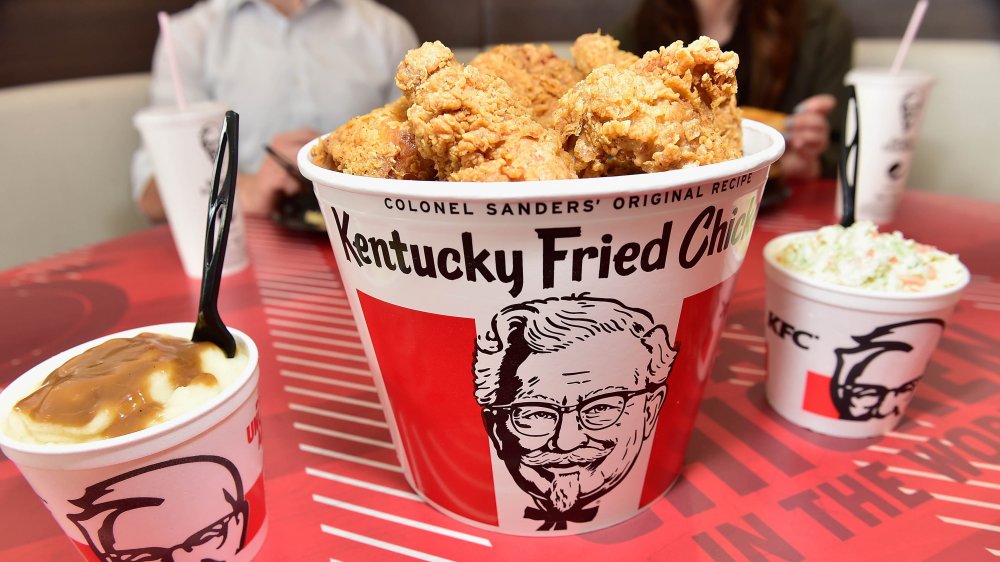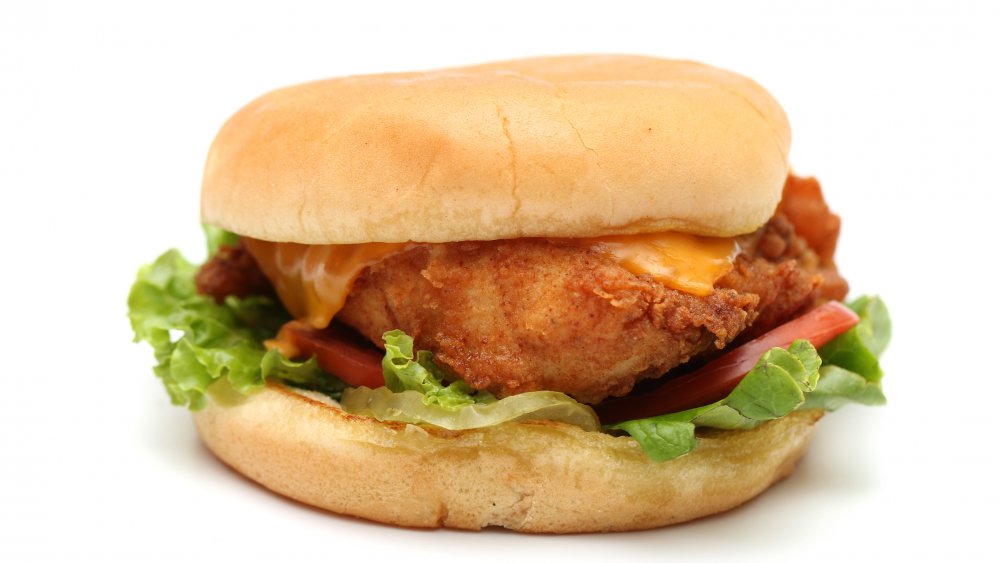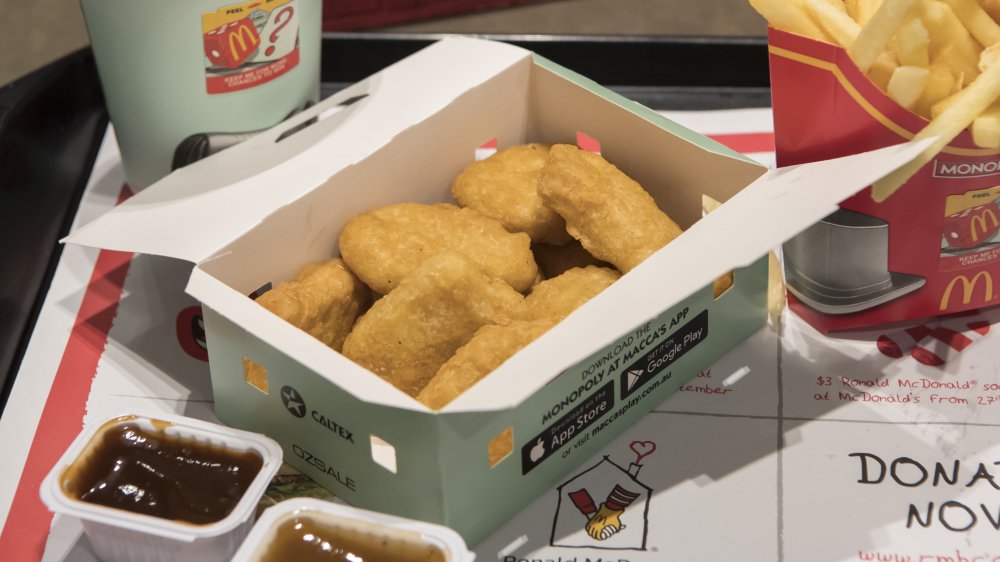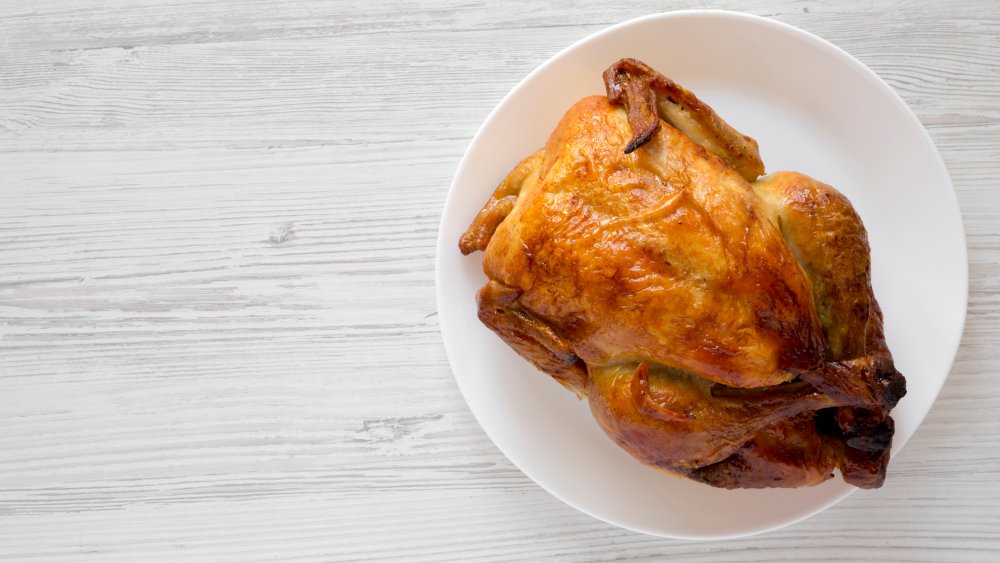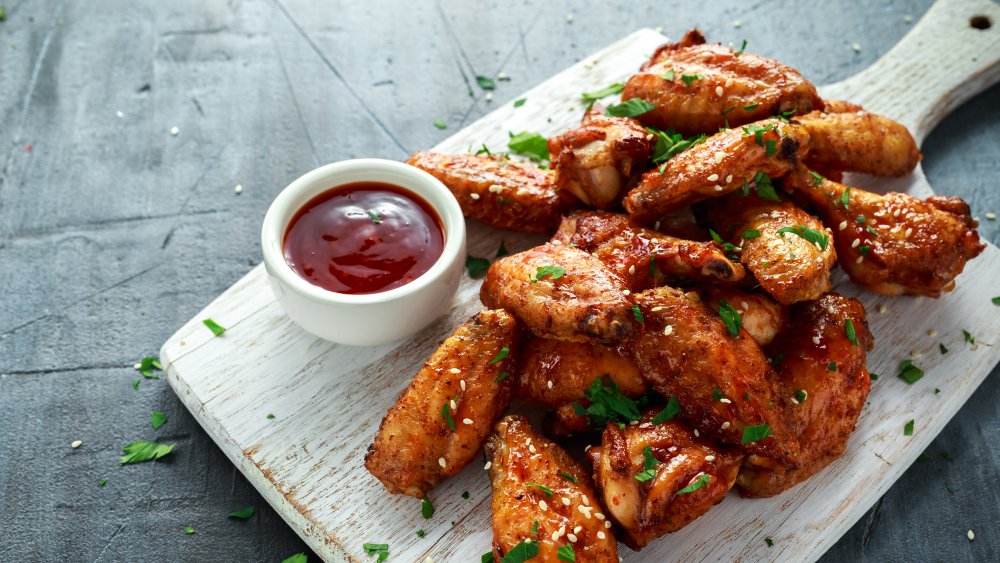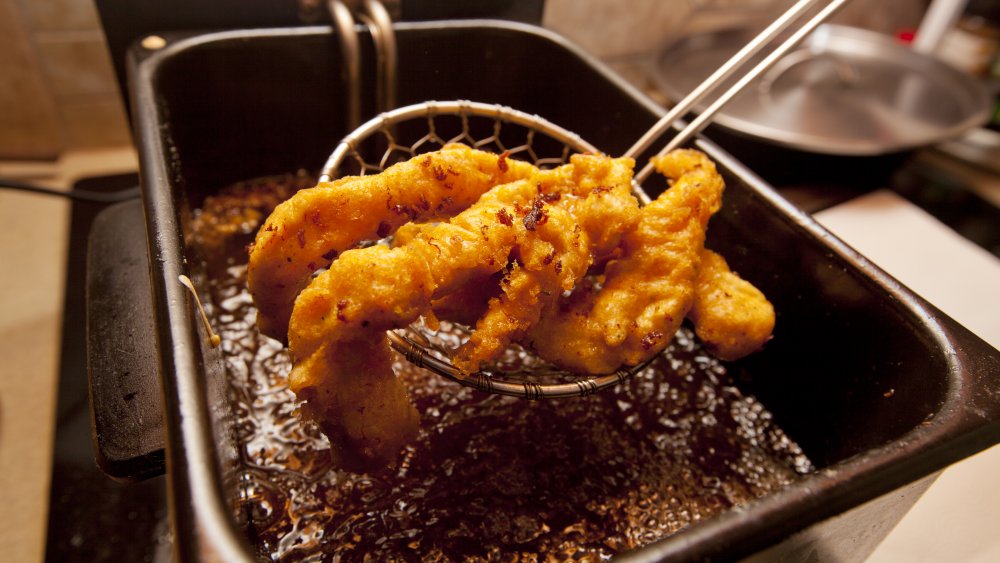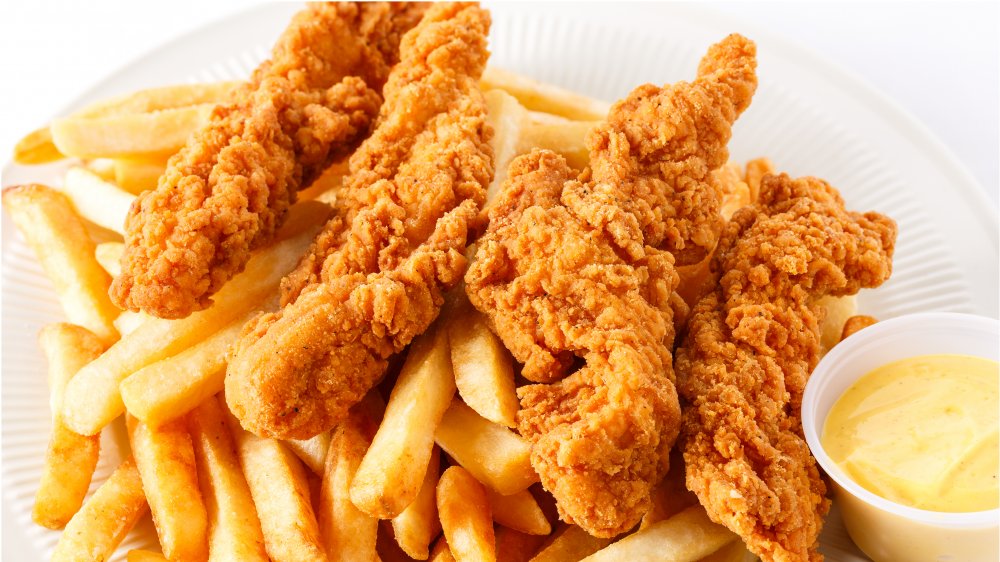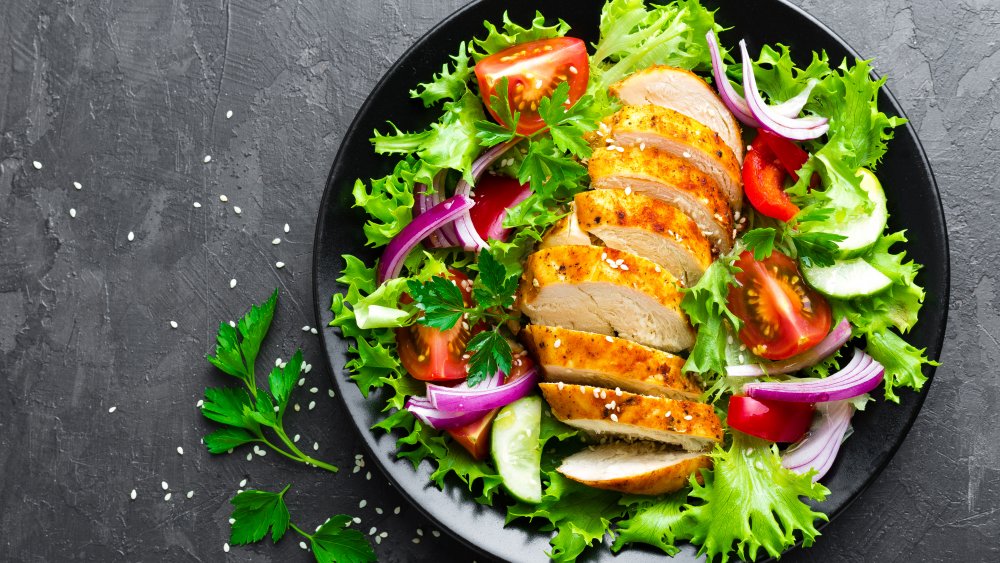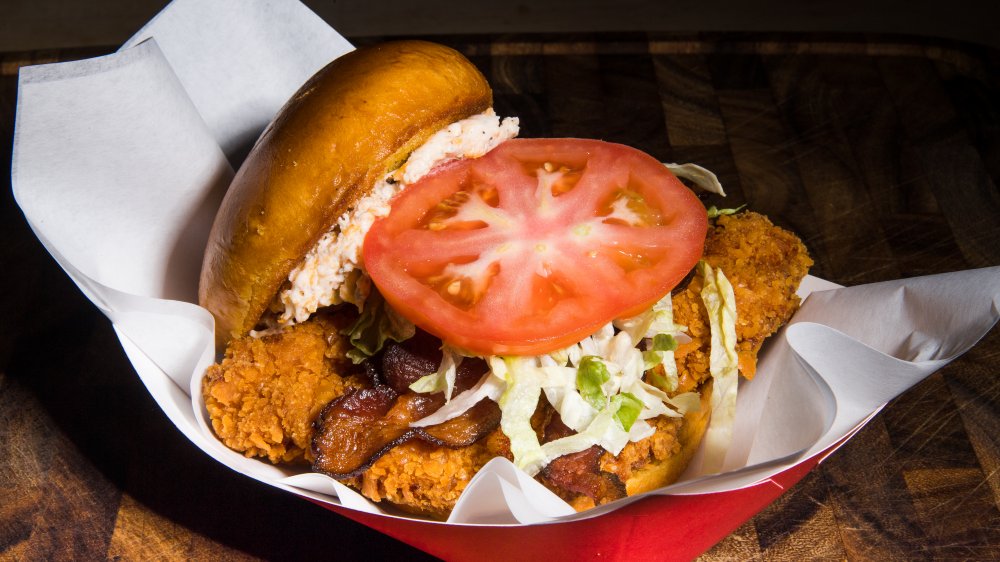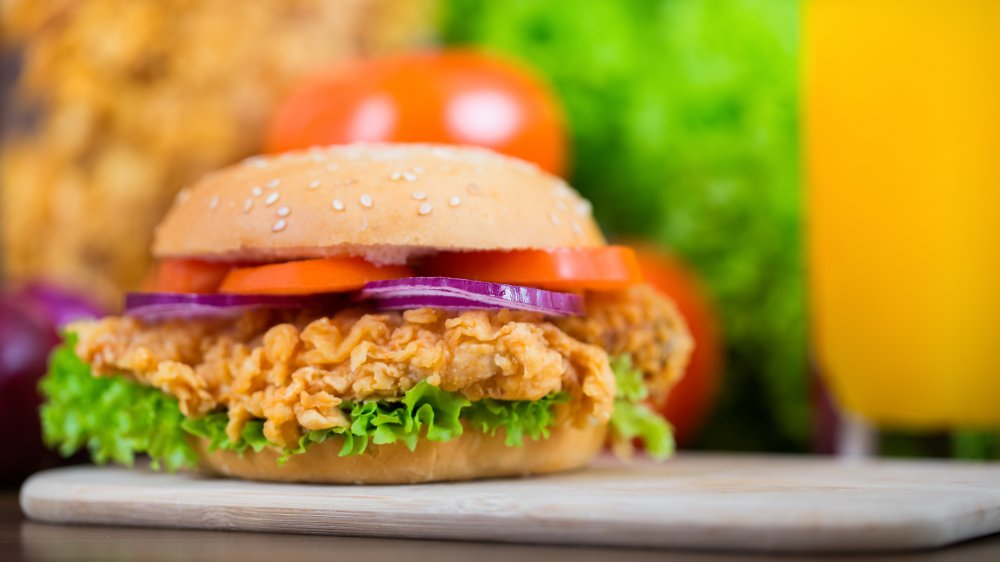Ingredients You'd Be Surprised Are In The Chicken You're Eating
Whether cooked at home or served up at a restaurant or fast-food joint, chicken has been a popular source of protein for years. In fact, according to 2017 statistics reported by the North American Meat Institute, the United States processed nine billion chickens that year, adding up to 42.2 billion pounds of chicken. That's a lot of chicken. And according to a June 2020 article in Supermarket Perimeter, the COVID-19 pandemic only served to boost sales of chicken even more, especially at supermarket retail outlets. Retail sales were up roughly 35 percent in the spring months of 2020 compared to the same period of time in 2019.
Many people consider chicken a healthier protein choice than red meats like beef, and as an American Heart Association article points out, there may be some truth to that assumption given that red meats tend to contain higher levels of saturated fats, which are associated with an increased risk of heart disease. That said, chicken isn't inherently healthy, and that's especially true when it's been processed, breaded, seasoned, and fried. In fact, much of the chicken you're consuming when you buy it prepared is laced with ingredients that may catch you off guard. Here's what you need to consider before grabbing a bag of chicken from the grocery store or ordering chicken nuggets from the drive-thru.
You might find MSG in fast food chicken
If you're not familiar with monosodium glutamate (commonly known as MSG), it's time to expand your knowledge. According to an article on Healthline, MSG is an additive in many processed foods that's used to enhance umami, or meaty-tasting, flavors. Some people report feeling symptoms like headaches, muscle tightness, and tingling, among others, when they eat too much MSG. It's possible that some people may have sensitivities to the additive. However, the FDA has claimed that MSG is safe to consume in moderation.
MSG is common in many Asian cuisines, and chances are, you'll come across it a lot if you go to Japan or Korea. Some claim that worries around MSG even have xenophobic origins, especially considering the fact that supposed MSG-induced illness was at one time dubbed "Chinese restaurant syndrome."
But when you get down to it, MSG does make things delicious, and that's why you'll often find it in fast food chicken from a multitude of restaurants. However, you are entitled to know what's in your food, especially if you want to avoid it, and that's a bit of a problem. While many companies list nutrition information for their foods on their websites, not all of them provide a full list of ingredients, so it may be hard to figure out if your favorite chicken sandwich contains MSG.
Don't be surprised if your chicken contains dimethylpolysiloxane ... which is also in silicone breast implants
Okay, no one's saying that your chicken nuggets (or other fried chicken items) are filled with silicone, but according to Is It Bad For You (IIBFY), there may be trace amounts of this silicone-derived additive in the fried foods you purchase, and people who raise alarm-bells at the use of dimethylpolysiloxane point to the fact that it's also used in products no sane person would put in their mouths, like bathroom caulk, mold expulsion agents, and polishes.
So why in the world would this be found in chicken? Well, as IIBFY points out, it's more or less non-biodegradable, which makes it a good food preservative (which also doesn't sound like a great selling point), and an "anti-foaming agent." It's this de-foaming agent part that usually plays a role in its inclusion in fried chicken, as many restaurants use dimethylpolysiloxane in their frying oils to help reduce oil splatter. Most of your favorite fast food restaurants use this stuff. But sometimes, it's sometimes hard to find out which do.
For instance, on the McDonald's chicken nuggets page, you have to read the super-fine print at the bottom of the page to see where the company has stated, "Our fried menu items are cooked in a vegetable oil blend with citric acid added as a processing aid and dimethylpolysiloxane to reduce oil splatter when cooking."
Look out for saline injections in your chicken
The concept of putting a "saline injection" in chicken may sound a bit alarming, especially if it calls to mind saline eye drops or nasal sprays, but it's actually a fairly benign additive found in most prepared chickens. Saline in and of itself is basically just a mix of salt and water (you know, in cooking terms, a brine), and according to The Daily Meal, it's probably why Costco's rotisserie chickens fly off the shelves almost as soon as they're cooked.
When brines are injected into chickens before they're cooked, the salt solution helps retain moisture, leading to a juicier (and more flavorful) finished product. And yes, because saline injections include salt (and usually other flavorings too), the resultant chicken tends to have a higher sodium content than if it had been prepared without the solution. That said, the salt content typically isn't overwhelming, although if it's available, it's a good idea to check the nutrition information for the chicken you're eating to make sure you're not overloading your system with extra sodium.
There's no chicken wing meat in your DiGiorno Wyngz and similar products
A 2016 article published in Mental Floss shed light on the "creative" spelling of DiGiorno's Wyngz product, which was released in 2011. The reality is, DiGiorno wasn't just trying to catch attention for a new product with an unusual spelling. Rather, the company wasn't legally allowed to advertise the product as "wings" because there's no guarantee there's actual meat from chicken wings in the DiGiorno product. In fact, if you look carefully at the Wyngz packaging, there's an asterisk next to "Wyngz" that points to smaller print that literally says, "with no wing meat."
So what, then, are DiGiorno's Wyngz made of? The good news is, they are made with chicken. According to the ingredient list on the box, they're "cooked chicken breast chunk fritter with rib meat."
To be fair, Wyngz* sounds better than "chunk fritter," so it's hard to blame DiGiorno for getting creative with the product's spelling. And it's important to note that if you see other products that have similar misspellings, check the fine print. To avoid false advertising claims, many companies will misspell a product to position itself as being the same or similar to a different, more commonly sought-after product.
Look out for different vegetable oils in your chicken
In some respects, fried foods are fried foods, but not all restaurants use the same type of frying oil, which could account (in part) for the different flavor experiences you enjoy at different locations. On top of that, if you're conscious about the specific type of oil you eat, some oils are associated with slightly different health outcomes.
For instance, according to Health, palm oil, found in many fast food chicken sandwiches including McDonald's Buttermilk Crispy Chicken Sandwich, is higher in saturated fats than some other vegetable oils, like olive oil (but not coconut oil). And even though palm oil has zero trans fats and is lower in saturated fats than butter or coconut oil, the high saturated fat content makes the oil far from being considered a "health food." Vegetable oils like canola oil should be considered your first choice when selecting healthier fats.
And if you or someone in your family has a peanut allergy, it's worth noting that some restaurants use peanut oil for frying. Granted, the American College of Allergy, Asthma, & Immunology, points out that most people with a peanut allergy can consume fully refined peanut oil without a problem. But the keyword there is "most." Talk to your doctor before giving it a try, and educate yourself on which products contain peanut oils. For instance, Chick-fil-A's Chicken Sandwich lists this fully refined oil in its ingredients.
There's carrageenan in that raw chicken in your fridge
Carrageenan is the type of ingredient you may just skip right by while reading an ingredient list. While it's not quite as chemically-sounding as many other ingredients found in processed foods (dimethylpolysiloxane, anyone?), it's not exactly a commonplace word either. But according to an article published on CBS News, it's a fairly common additive.
So what is carrageenan, exactly? It's basically seaweed. Or rather, a seaweed extract that's used as an emulsifier and thickening agent and is found in a multitude of foods, including raw chicken (it helps retain water and deliver that "juicy" flavor) and dairy products, like chocolate milk. According to an article on The Kitchn, carrageenan can be found in Costco's rotisserie chicken, and a little digging shows that it's been added to KFC's Popcorn Nuggets, as well.
In the grand scheme of things, carrageenan seems to be a less offensive food additive in chicken than many ingredients on an average package, but according to The Journal of Clinical Allergy & Immunology, there has been at least one case of anaphylactic shock related to a carrageenan allergy (when consumed in a large dose). Chances are though, when it comes to the chicken in your freezer, it shouldn't be too big of a deal.
There might be transglutaminase, or meat glue, in your chicken nuggets
It's not clear who came up with the phrase "meat glue," but whoever did it should not be in marketing. If DiGiorno's "chunk fritter" chicken meat wasn't good enough to be marketed as such, the phrase "meat glue" should never have been uttered in a forum where people have ears. You just can't un-hear it.
Well, according to an article on Reader's Digest, transglutaminase (TG), or "meat glue," is a controversial food additive that's been banned by the European Union but is still considered "generally recognized as safe" by the FDA in the United States. Transglutaminase itself is a naturally occurring enzyme made from the blood plasma of livestock like pigs and cows that can help form bonds between proteins. Thus, because proteins bond together with its use, it's been dubbed "meat glue."
The reason the European Union has banned its use is that when these bonds between proteins are formed, there's a higher likelihood of introducing bacteria into the product. And as such, this introduces a higher likelihood for consumers to experience food poisoning. While TG is a common additive in products like chicken nuggets and patties, Reader's Digest estimates that the percentage of meat products per year in the United States that contain this additive is a measly 0.016. If you want to avoid it, just look for "transglutaminase," "TG enzyme," "enzyme," or "TGP enzyme" on the ingredients list.
There might be trans fats in your chicken
Technically, the FDA has officially banned trans fats from being added to packaged (processed) foods or restaurant foods. This is because trans fats, which are usually created when a liquid fat (like vegetable oil) has been chemically altered through hydrogenation to create fat that's solid at room temperature (like Crisco or margarine), have been linked to negative health outcomes, like increased risk of heart disease.
That said, there's a loophole. Because trans fats occur naturally in very small amounts, the FDA has allowed restaurants and food manufacturers to list a food as having zero trans fats as long as there are fewer than 0.5 grams of trans fat per serving. This allows restaurants and manufacturers to continue using hydrogenated oils as part of their products as long as they're only present in small amounts.
So if brands can list foods as having no trans fats when they actually contain small amounts of them, how do you know if your favorite fried chicken is actually trans fat-free? The key is in the ingredient list. Look for "hydrogenated" or "partially hydrogenated" oils, as you'll note on the ingredients for many fast food chicken products. This is typically a dead giveaway that, even if a product has a trace amount of trans fats, it's still there. And you might be better off simply assuming that most of your favorite fried fast food items contain trans fats — an article on Healthline points out as much.
There might be gluten in your non-fried chicken
If you're at all familiar with gluten, it probably isn't too big of a surprise that most fried chicken products contain the substance. After all, according to Medical News Today, "gluten is a family of proteins found in grains, including wheat, rye, spelt, and barley." And what's the breading found on fried chicken? Usually, it's a hotbed of wheat, and thus, gluten.
What you might be surprised about, though, is that gluten isn't just found in fried chicken — it's found in other prepared chicken dishes, too. An article on Today points out that chicken treated with modified food starches, like Costco's rotisserie chicken, are possible culprits. This is because modified food starches are typically made from genetically engineered corn or wheat. The thing is, many people can eat gluten without experiencing any type of problem, but there are others who have an autoimmune disease called celiac disease or a non-celiac gluten sensitivity that can make these dishes unhealthy. These individuals may experience severe gastrointestinal distress after consuming even trace amounts of the proteins and need to do their best to avoid it altogether.
Because wheat allergies are common, look for information on your chicken's product packaging to see if modified food starch is listed as an ingredient. Then check for notes about whether the product was made at the same facility where wheat is processed. These clues can help you determine if a prepared chicken product is gluten-safe.
There's probably sugar in your chicken too
Fried chicken usually doesn't taste particularly sweet, right? Of course, that may depend on what you're eating — honey barbecue hot wings will certainly offer a sweet kick. But when you grab a basic chicken sandwich or you order a four-piece pack of chicken nuggets for your kids, you're probably not thinking too much about sugar intake. But, believe it or not, almost all prepared chickens come with added sugars. In fact, according to a review of sugar content in fast food chicken products published on Forbes, added sugars were found in most of the restaurants' grilled and charbroiled products. These included chicken from Subway, Firehouse Subs, Panera, Chick-fil-A, Hardee's, Wendy's, Carl's Jr., Panda Express, Burger King, and McDonald's.
In fact, the only restaurants whose grilled and charbroiled meats made it out without a bit of sugar listed were Dunkin Donuts, Taco Bell, and Chipotle. Of course, none of the restaurants tested stuck solely to listing "sugar" in the ingredients — that might be too obvious. Rather, they often opted for slightly more subtle ingredients, including cane molasses, corn syrup, or dextrose.
While many chicken products do contain sugar (sugar does tend to make things taste better), it's usually pretty limited. If you're keeping an eye on your sugar intake, or you know you need to monitor your blood sugar response, make sure you're looking at the nutrition information to note how many grams of sugar are included in your favorite chicken meal.
There's food coloring in fast food chicken
You'd think a delicious dish of fried chicken could be made and served as naturally as possible, without needing to add food colors to the breading or the chicken itself. Unfortunately, you'd think wrong. If you start perusing ingredient lists for many fast food chicken orders and grocery store packaged chicken products, you're likely to be surprised by how many of them list food coloring as part of their ingredients. For instance, Chick-fil-A lists "color" (in the form of paprika, which you shouldn't have to be too worried about) on its nutrition webpage, while Tyson lists "caramel color" as one of the ingredients for its Buffalo Style Chicken Strips.
The idea is pretty simple — food companies realize that people want their food to look as appealing as possible, and sometimes that means engineering the perfect color palette for a platter of buffalo chicken wings or a kid-friendly chicken nugget. This is especially true when companies rely on every item sold to look identical. By adding food coloring, they can help ensure consistency in color no matter what.
